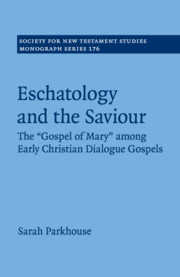Book contents
- Eschatology and the Saviour
- Society for New Testament Studies Monograph Series
- Eschatology and the Saviour
- Copyright page
- Contents
- Acknowledgements
- Abbreviations
- Introduction
- Part I
- Part II
- 3 The Narrative Frame of the Gospel of Mary
- 4 The Cosmos and Its Undoing
- 5 The Journey of the Soul
- Conclusion
- Book part
- Bibliography
- Index
3 - The Narrative Frame of the Gospel of Mary
from Part II
Published online by Cambridge University Press: 16 August 2019
- Eschatology and the Saviour
- Society for New Testament Studies Monograph Series
- Eschatology and the Saviour
- Copyright page
- Contents
- Acknowledgements
- Abbreviations
- Introduction
- Part I
- Part II
- 3 The Narrative Frame of the Gospel of Mary
- 4 The Cosmos and Its Undoing
- 5 The Journey of the Soul
- Conclusion
- Book part
- Bibliography
- Index
Summary
Although the Gospel of Mary is a dialogue gospel, the text’s narrative frame is just as integral to understanding the message of the gospel as the eschatological teachings in the dialogues. The narrative frame includes Jesus’ departure, Mary’s intervention, and the ensuing dispute among the disciples. This chapter explores possibilities for what was contained in the missing opening pages of the Gospel of Mary, firmly situating the text within the dialogue gospel genre. It then analyzes the Saviour’s farewell discourse, which encourages the disciples to be active participants in the Christian message of salvation. The section on Mary’s intervention focuses on her relationship with the male disciples and her relationship with Jesus, and argues that the Coptic manuscript heightens animosity between the disciples in contrast to the earlier Greek versions. Mary’s relationship to Jesus, on the other hand, is one of succession. The final part of the narrative frame sees the disciples split into two factions, with Mary and Levi on one side and Peter and Andrew on the other. It is unclear at the ending of the gospel whether the disciples are reconciled, and this is explored in light of other dialogue gospels such as the Pistis Sophia.
- Type
- Chapter
- Information
- Eschatology and the SaviourThe 'Gospel of Mary' among Early Christian Dialogue Gospels, pp. 129 - 174Publisher: Cambridge University PressPrint publication year: 2019

